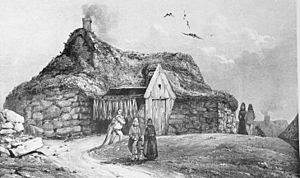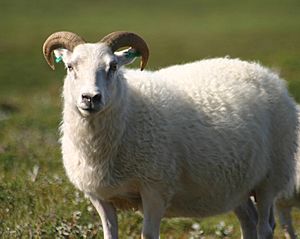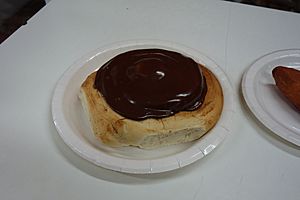Icelandic cuisine facts for kids
Icelandic food, also called Randabrauð, has a long and interesting history. Key foods in Iceland are lamb, dairy products, and fish. Fish is very important because most people in Iceland have always lived near the coast.
Some popular Icelandic foods are skyr (a yogurt-like dairy product), hangikjöt (smoked lamb), kleinur (a fried pastry), laufabrauð (thin fried bread), and bollur (buns). Þorramatur is a special meal served at midwinter parties called Þorrablót. It includes different kinds of traditional cured meats and fish. These are served with rúgbrauð (a dark, sweet rye bread) and brennivín (an Icelandic drink). The unique flavors of these old foods come from how they were preserved. Methods included pickling in fermented whey or salty water, drying, and smoking.
Today, Icelandic chefs focus on using fresh, high-quality ingredients. Many restaurants in Iceland specialize in seafood. There's an annual cooking competition called Food and Fun. Chefs create new dishes using fresh Icelandic ingredients. People are very proud of their lamb, seafood, and skyr. Other local ingredients include seabirds, waterfowl (and their eggs), salmon, and trout. Wild berries like crowberry and blueberry are also used. You can also find rhubarb, Iceland moss, wild mushrooms, wild thyme, and dried seaweed.
Because Iceland has a harsh climate, animal products have always been a big part of its food. However, people's tastes are changing to be more like those in other European countries. For example, people eat a lot more vegetables now. They eat less fish than before, but still much more than most other developed countries.
How Did Icelandic Food Develop?
The roots of Icelandic food come from Scandinavian cuisine. This is because Icelandic culture is Nordic, and its economy was based on farming for a long time. Several important events in Icelandic history changed its food traditions.
When Christianity came to Iceland in 1000 AD, people started fasting. They also stopped eating horse meat. A bigger change for farming and food happened when the Little Ice Age began in the 1300s. Farmers could no longer grow barley. They had to import all their grains. The colder weather also changed homes. The large longhouses of early settlers were replaced by smaller Icelandic turf houses with proper kitchens. These turf houses were used until the 1900s.
Historians often see the Protestant Reformation (starting in 1517) as the start of the modern era in Iceland. Farming methods stayed mostly the same from the 1300s to the late 1700s. Then, new ideas from the Age of Enlightenment brought changes. A Danish–Icelandic Trade Monopoly (1602-1787) also affected food. But Danish cuisine had the most influence in the 1800s and early 1900s. This was when Iceland had close ties with Denmark. In the early 1900s, commercial fishing grew. This slowly changed food from traditional dairy and meat to more fish and root vegetables. People started using fresh ingredients more often instead of only preserved foods.
Food in Medieval Iceland
When people from Scandinavia and Viking colonies settled Iceland, they brought their farming and food traditions. Research shows that Iceland's climate was much milder in the Middle Ages. Records say that barley and oats were grown. Most of these grains were used for porridge or beer. Cattle were the main farm animals. But farms also had poultry, pigs, goats, Icelandic horses, and Icelandic sheep. The animals first brought to Iceland have lived in isolation. This means they are unique breeds, sometimes called "settlement breeds" or "Viking breeds."
How Food Was Kept Fresh
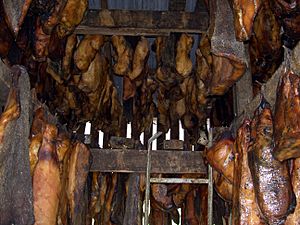
Fish was stored in salt. Before the Black Death, Iceland exported dried fish to Norway. But salt was harder to find in Iceland than in Norway. Saltmaking, by boiling seawater or burning seaweed, slowly stopped. This happened because there wasn't enough firewood in the 1300s due to overgrazing. Instead of using salt, Icelanders began to preserve meat in fermented whey. This method was known in Norway but wasn't used much there.
Archaeological digs in old farms show large round holes in storage rooms. These held barrels of lactic acid for preserving food. Two old stories tell of men who survived a burning house by hiding in an acid barrel. Medieval Icelanders used fermentation for both fish and meat. This method greatly changes the taste, making it strong like cheese. Fermentation is still used for shark (like hákarl), skate, and herring. Smoked and dried meat and fish were also common.
Cheese and Dairy
Cheese was made from goat, sheep, and cow milk. Skyr, a soft yogurt-like cheese, came from Norway. It has only survived in Iceland. The whey left from making skyr was soured and used to store meat. Skyr became so popular that other cheesemaking traditions disappeared until the 1900s. Cheesemaking was often done in mountain huts in late spring. Farmers would separate young animals from their mothers to milk the adults. They often made cheese while in the highlands.
Cooking and Meals
The first settlers' longhouses usually had a long fire in the center. Holes were dug in the floor around it. These were used as earth ovens for baking bread and cooking meat. Women would put dough or meat in the hole with hot coals and cover it. They boiled liquids in wooden containers by putting hot stones directly into the liquid. Cooking was mostly done on the floor.
In the 1300s, Icelandic turf houses replaced longhouses. They had a raised stone hearth called hlóðir for cooking. The colder climate meant barley could no longer grow. Sheep became more common than cattle. Iceland had to import all its grains. Because firewood was scarce, people used peat, animal waste, and dried heather for fuel.
In medieval Iceland, people ate two meals a day. Lunch, or dagverður, was around noon. Supper, or náttverður, was at the end of the day. Food was eaten from bowls. Wooden tankards were used for drinking. Later, bulging casks called askar were used for serving food. Wealthy people used fancy drinking horns for special events. Spoons were the most common eating tool, made of horn or bone. Except for feasts, people ate from their laps while sitting on their beds. The farmer's wife shared the food among the family. In richer homes, a special butler called bryti did this.
Food in More Recent Times
A huge natural disaster, the Laki eruption, happened in 1783. Ten years earlier, Danish merchants were allowed to live in Iceland again. Five years later, the trade monopoly ended. Some Danes stayed, and some Icelanders became merchants.
During the Napoleonic Wars (1803–1815), there was a shortage of goods. Merchant ships were busy with the war. Icelanders had to rely on themselves. They started growing and eating more local vegetables. In the 1800s, a feeling of nationalism grew. Schools for women also helped formalize traditional cooking methods.
Danish Food Influence
The first cookbooks in Icelandic were Danish recipes published in the 1700s. They aimed to bring upper-class Danish food to Iceland. These recipes sometimes had simpler versions for farmhands. Danish food had influenced Iceland even before that through trade.
Danish merchants who settled in Iceland often had homes that mixed Danish and Icelandic customs. Reykjavík grew in the late 1700s and became a center for both Icelandic and Danish food traditions. Fishing villages also formed in the 1800s. Danish influence was strongest in baking, as Iceland had few native baking traditions. Danish bakers started working in Reykjavík and Akureyri around the early 1900s. Some Danish baking traditions have lasted longer in Iceland than in Denmark.
Growing Vegetables
In the late 1600s, some farmers started growing vegetables. But it didn't become common until the early 1800s, when the Napoleonic Wars stopped merchant ships. Danes living in Iceland often started the first vegetable gardens. Early popular vegetables included cabbage, turnip, rutabaga, and potato. In Iceland, these were usually boiled and served with meat and fish, or mashed with butter.
Girls' Schools and Modern Food
In the early 1900s, many home economics schools for girls opened in Iceland. In these schools, during a time of strong national pride, many Icelandic cooking traditions were written down. They were published in large recipe books later. A new focus on food hygiene and fresh ingredients was important. This was new for a country where food traditions were based on long-term preservation.
The economy grew, based on exporting seafood. The new generation started to reject many old foods. They liked the idea of "freshness" and "purity" from sea ingredients. In the late 1940s, many Icelanders moved to cities. They formed groups in Reykjavík that brought back old traditions. These groups organized midwinter festivals where they served "Icelandic food," which were traditional country foods served buffet style. This was later called Þorramatur.
Cooperatives and Dairy
In the early 1900s, farmers near towns sold their products to shops and homes. To help with the Great Depression in the 1930s, the Icelandic government created state monopolies on some imports, including vegetables. They gave regional farmers' cooperatives a monopoly on dairy and meat production for consumers. This meant smaller private producers went out of business.
These large cooperatives invested in modern facilities for food safety. They still control most agricultural production in Iceland. They also created new cheesemaking methods based on popular European cheeses like gouda, blue cheese, and camembert. Cheesemaking (besides skyr) had almost disappeared in Iceland since the 1700s. The cooperatives have developed many new products, especially dairy. For example, they sell sweet drinks made from whey. They also made "Skyr.is," a creamier, sweeter skyr, which made this old food very popular again.
Fishing Industry
Industrial fishing with trawlers began before World War I. Fresh fish became cheap and a main food in fishing villages. Until about 1990, Icelanders ate much more fish per person than any other European country. Since then, fish prices have risen, so people eat less fish.
Types of Food in Iceland
Fish Dishes
Icelanders eat fish caught in the North Atlantic Ocean. Fresh fish is available all year. They mostly eat haddock, plaice, halibut, herring, and shrimp.
Hákarl (Fermented Shark)
Hákarl means 'shark' in Icelandic. It is shark meat that has been preserved by fermenting it. It is part of the þorramatur meal. People often eat it with brennivín, a local strong drink.
Meat Dishes
Traditionally, sheep were the main source of meat. Sheep are the most common farm animal in Iceland. They were also used for their milk and wool. A sheep was worth more alive than dead. When a sheep was butchered (usually young males or ewes that couldn't have lambs), almost all of it was used for food. This food was carefully preserved. Lambs are usually butchered in the autumn when they are over three months old. After Christianity came, horses were only eaten if there was no other food. But after the mid-1700s, attitudes changed. Horse meat, usually salted and boiled or made into smoked sausage, has been common since the 1800s.
Icelandic beef is usually good quality. This is because the cattle are grass-fed and raised without growth hormones. However, beef was not a traditional food, so sometimes lower quality meat was sold.
Wild Game
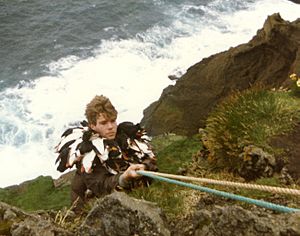
Small wild game in Iceland includes mostly seabirds (like puffin, cormorant, and great black-backed gull) and waterfowl (like mallard and goose). Some seabird meat contains fish oil. It is soaked in milk overnight to remove the oil before cooking. Ptarmigan is also found, but hunting them is banned because their numbers have dropped. Ptarmigan, served with creamy sauce and jam, has been a traditional Christmas meal in many Icelandic homes.
Seal hunting was common where farmers could find seal breeding grounds. Seal was an important food. Unlike mutton, seal meat was usually eaten fresh or preserved for a short time in salt water. Seal meat is not commonly eaten anymore.
Whaling on a large scale was not possible until the late 1800s. Small whales were hunted near the shore with small fishing boats. Beached whales were also eaten. The Icelandic word for a beached whale, hvalreki, still means a stroke of good luck. When Iceland started commercial whaling (mostly minke whales) in the early 1900s, whale meat became popular. It was a cheap red meat. It can be cooked like beef. Commercial whaling stopped in 1992 when Iceland left the International Whaling Commission. Some whale meat was still sold from whales that beached or were accidentally caught. In 2002, Iceland rejoined, and commercial whaling started again in 2006. Whale meat is available again, but it's more expensive.
Reindeer were brought to Iceland in the late 1700s. They live wild in the eastern moorlands. A small number are hunted each autumn. Their meat is sold in stores and restaurants most of the year. Reindeer meat is a special and expensive treat.
Rules on Meat Imports
Importing raw meat to Iceland is very strict. The government worries about diseases. Because Iceland is isolated, most farm animals there have no natural protection against diseases common in other countries. So, tourists cannot bring in even cured ham or sausage. Customs officers will take them.
Dairy Products
Dairy products are very important to Icelanders. The average Icelander eats about 380 liters (100 US gallons) of dairy products in one year.
Fruits and Vegetables
Growing and eating vegetables is increasing. Production went from about 8,000 tonnes in 1977 to almost 30,000 tonnes in 2007. The cold climate means farmers don't need to use many pesticides. Vegetables like rutabaga, cabbage, and turnips are often started in greenhouses in early spring. Tomatoes and cucumbers are grown entirely indoors. Iceland imports almost all sweet fruits, except for berries. Since the early 1900s, it has been possible to grow barley for people to eat in a few places. This is the first time since the Middle Ages.
Bread and Pastry
Modern Icelandic bakeries offer many kinds of bread and pastry. The first professional bakers in Iceland were Danish. This still influences Icelandic baking. Popular local favorites include snúður, a cinnamon roll usually topped with glaze or melted chocolate. Another is skúffukaka, a chocolate cake baked in a pan, covered with chocolate glaze and sprinkled with ground coconut.
A type of layer cake called randalín or randabrauð has been popular since the 1800s. These cakes have five layers of cake, about 1/2 inch (13 mm) thick. Between the layers are fruit preserves, jam, or icing. One version, vínarterta, was popular in the late 1800s. It had prune layers and became a tradition for Icelandic immigrants in the U.S. and Canada.
Traditional breads still popular include rúgbrauð, a dark, moist rye bread. It's traditionally baked in pots or special boxes in holes near hot springs. Another is flatkaka, a soft brown rye flatbread. A common way to eat hangikjöt is in thin slices on flatkaka. Other breads include soft skonsur and Westfjord Wheatcakes.
Traditional pastries include kleina, a small fried dough bun. The dough is flattened, cut into shapes, and then one end is pulled through a slit to form a "knot." This is then deep-fried. Laufabrauð (meaning "leaf bread") is a very thin wafer. Patterns are cut into it with a sharp knife, and it's fried until crisp. It's a traditional Christmas food, sometimes served with hangikjöt.
Special Meals and Feasts
Christmas Dishes
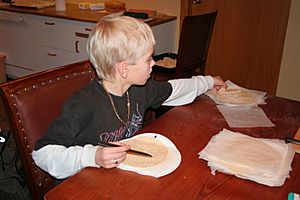
In Iceland, Christmas dinner is traditionally served on Christmas Eve. Main dishes often include hangikjöt (smoked lamb), hamborgarhryggur (salted pork rib), and various types of game. These can be ptarmigan stew, puffin (sometimes lightly smoked), or roast greylag goose. They are usually served with a creamy sauce or mushroom sauce, boiled potatoes, and peas. Pickled beetroot or red cabbage and jam are also common. A traditional dessert is rice pudding with raisins, topped with cinnamon and sugar. This is called jólagrautur ("Yule pudding").
On December 23 (Saint Thorlak's Day), there's a tradition to serve fermented skate with melted tallow and boiled potatoes. This tradition comes from the Westfjords. Boiling the Christmas hangikjöt the day after serving the skate is said to get rid of the strong smell that can linger in the house.
In the weeks before Christmas, many families bake different kinds of cookies. These include piparkökur, a type of ginger biscuits often decorated with colored glaze. Laufabrauð is also fried a few days before Christmas. Decorating it is often a family gathering.
Þorramatur (Midwinter Feast)
The idea of Þorramatur started in a Reykjavík restaurant in 1958. They advertised a platter of traditional country food, linking it to the Þorrablót festival. This idea became very popular. For older people, the taste brought back memories of growing up in the countryside before World War II and the growth of cities. However, in recent years, þorramatur has become known for being strange or unusual. Many modern Icelanders might not like the sound of it. But many common foods are also traditional, even if they aren't called þorramatur.
Celebration Meals
Birthdays, weddings, baptisms, and confirmations are times to invite the extended family for a lunch or "afternoon tea." This is called kaffi in Icelandic, as filter coffee is usually served. Traditional dishes include the kransekage (a cake of Danish origin) and different types of brauðterta. These are similar to the Swedish smörgåstårta. They have fillings like shrimp, smoked salmon, or hangikjöt with lots of mayonnaise between layers of white bread. Also popular for big family gatherings are various sponge cakes. These are topped with fresh or canned fruit, whipped cream, marzipan, and meringue. This tradition is made fun of in a famous part of Halldór Laxness's novel, Under the Glacier. The character Hnallþóra insists on serving many kinds of rich cake to the bishop's visitor at every meal. Her name has become a nickname for this type of cake.
See also
 In Spanish: Gastronomía de Islandia para niños
In Spanish: Gastronomía de Islandia para niños


